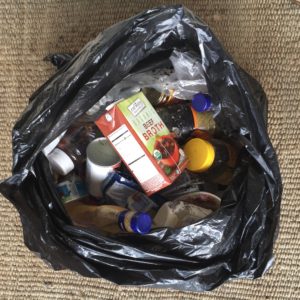One of The Joy of Plenty’s goals is to help reduce the amount of food the world wastes. Every day America wastes enough food to fill the Rose Bowl. Yes, that Rose Bowl—the ninety-thousand-seat football stadium in Pasadena, California.[1]You read that right; that’s every day, not every year. The Natural Resources Defense Council claims Americans lose up to 40 percent of our food from farm to fork to landfill.[2] Reducing the amount of food waste (or, waste as food) will dramatically help create planetary health since agriculture leaves a huge footprint on our planet.
While The Plenty Method can’t do anything about the food that rots in a farmer’s field or deteriorates in a warehouse, it can help you trim your household food waste. How does The Plenty Method do this? By helping you learn how to:
Purchase
- Make a focused Master Ingredients List that encourages you to purchase fewer but more versatile kinds of food. Less variety leads to less waste. Creatively transform the ingredients you already have on hand instead of buying a new single-use item that could end up as half-eaten food waste.
- Buy food close to the source so it is fresh and lasts longer.
- Buy longer-lasting foods instead of those that rapidly spoil.
Store
- Learn how to store food properly to prevent premature spoilage.
- Store and preserve food properly, then retrieve it from storage as needed. This is a flip-flop from buying food, thinking that you will use it, but then your plans change. You forget the food; it spoils and gets tossed.
- Store staple ingredients in clear, airtight glass containers so they are visible; no out-of-sight, out-of-mind food left to rot.
- Learn to extend the life of food by removing oxygen by using a vacuum-packing machine and other methods.
Sense
- View manufacturer’s expiration dates as suggestions only; tune into your senses to determine if a food is safe to eat.
- Understand the shelf life of foods to know when to watch for subtle changes in flavor, texture, and smell that tell you to use it soon.
Connect
- Experience more connection with your food by learning to appreciate and respect it. This awareness encourages you to tune into your food to prevent spoilage.
- Share or exchange food with others before it spoils.
Use
- Use or preserve avoidable waste, such as peelings, meat bones, and overripe fruits. For example, freeze cream in ice cube trays. Use old bread for breadcrumbs, croutons, French toast, or bread pudding. Transform carrot tops into carrot-pesto. Use Parmesan cheese rinds to flavor soups, and so on.
- Redefine what fresh means, and resurrect foods that are thought of as “bad.” For example, a cauliflower with brown spots is usually perfectly edible when you trim them off. A mealy apple is delicious when you bake it. Try putting a soggy banana in a smoothie or banana fritter.
Please consider learning The Plenty Method to reduce your
household food waste. Every little bit helps! Or, as I like to say “Big is
just a whole bunch of little”. One small step, one small footprint can add
up to huge progress down the road. One person can make a difference and that
person is you!

[1] Jonathan Bloom, American Wasteland: How America Throws Away Nearly Half of its Food (and What You Can Do About It) (Cambridge, MA: Da Capo Press, 2010), xi
[2] Dana Gunders, Natural Resources Defense Council Issue Paper, August 2012, https://www.nrdc.org/sites/default/files/wasted-food-IP.pdf
